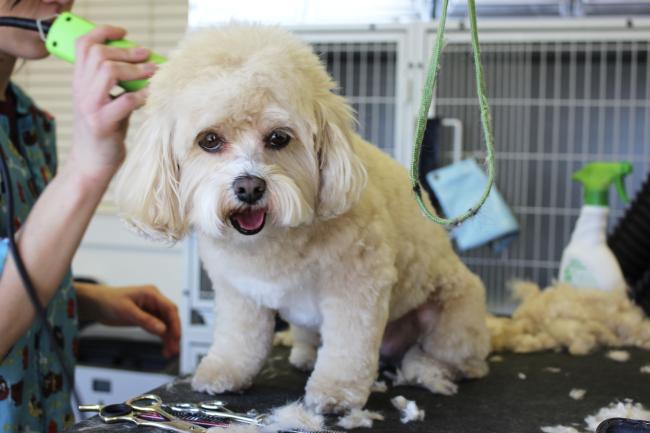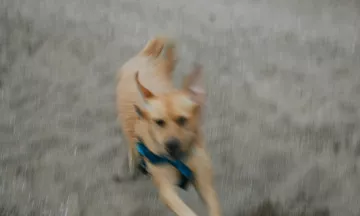It seems like it will never end: your dog takes off his winter coat and you find hair all over the place. Now that the temperatures are rising, the shedding seems worse than ever. How does 'moulting' work exactly? What do you need to do to make things as comfortable as possible for your dog, and what should you avoid doing?
The coat of your dog is a beautiful and intelligent thing that keeps your dog healthy, dry or cool. The skin of your dog keeps itself in a healthy condition and the coat of your dog regulates the temperature itself. Twice a year, when it gets warmer or colder, many dogs and cats suddenly shed a lot of hair. This moulting period can take up to 3 to 4 weeks and can cause a lot of irritation to both the pet and the owner. With some dogs, the hair loss seems never-ending and the amount of hair that he loses can be very impressive. It is important to know what you as a pet owner can do during this period.
Know your dog's fur
Every dog's coat is different. The duration and intensity of the shedding varies per dog breed. Therefore, every dog breed needs a different approach when it comes to coat care. Some dogs shed a constant bit of hair throughout the year. These are, for example, dogs with wool- or curly coats such as the Labradoodle. They do not moult 2 times a year during peak season, but continuously shed a bit of hair. Loose hairs must be brushed out regularly. Dogs with a wire coat also continuously shed a bit of hair, but the hairs don't fall off in the coat. Twice a year, the coat must be 'plucked' to remove the old hair and release the new undercoat. It is important that these dogs get the right coat care: for example, if you are going to shave a wire coat dog, then his fur will become very grey and the dead hair will start to itch. If you do not brush a long haired dog in time, the hair will start tangling and the fur will become dirty and smelly.
Dogs with smooth or short hair also shed hair all year round, but twice a year at the changing of the seasons they suddenly lose a LOT of hair. Now that it is getting warmer, many dogs take off their 'winter coat' and exchange it for a shorter and thinner summer coat. The result: you can find hairs all over the house and it seems like it's never going to end. What can you as a pet owner do during this period?

Moulting is natural and healthy
Dogs traditionally used to 'groom' their own fur which is quite easy, because, the coat largely regulates itself. In the moulting period, dogs were able to take care of their own fur by licking, taking mud baths or rubbing the fur against bushes to get rid of excess hair.
The moulting happens in a natural way under the influence of temperature and light. When the seasons change, the coat responds to the new circumstances. But because dogs nowadays live indoors a lot, that balance sometimes gets disturbed. During winter, for example, dogs also spend a lot of time indoors by the fireplace. And during the summer they also experience a lot of temperature shifts: from the warm outdoors to the air conditioning indoors. Additionally, humans have bred long-haired and wire-haired breeds. As a consequence, this means that we need to help our dogs take care of their fur.
Brushing: yes or no?
Regular brushing removes the excess hair and, especially during the moulting period, brushing can give the dog some relief of itchy hairs. For short and smooth-haired dogs, it is better to be a little reluctant with the brushing though. Outside the moulting season, brushing is hardly necessary. Too much brushing can cause skin damage.
Make sure to always choose the right dog brush. For dogs with a shorter coat, use a soft brush (such as a rubber brush or a bristle brush). For dogs with a longer, wired coat you can use a comb or slicker brush. Do not press too hard in the fur so you don't irritate the skin.
To prevent tangling it is important to take extra care:
- Around the ears
- At the nose / mouth
- In the armpits
- Around the soles of the feet and between the toes
- Under the tail
Are you hiring a dog sitter for an overnight stay or for doggy daycare? Then tell your sitter about the type of coat of your dog and give your sitter the right dog brush. Make clear arrangements with your dog sitter so that he or she knows what's best for your dog's fur.
Bathing or not?
During the moulting period, bathing can provide a bit of relief for some dogs. The running water and the use of a neutral dog shampoo can loosen some of the dead hair. Afterwards, blow-dry the coat with a dryer to prevent the fur from tangling. You can do this 1-2 times during the moulting period. Dogs with a short or silky coat don't need to be shampooed unless they are really dirty after swimming in a stinky pool or rolling in smelly stuff. Too much washing can disturb the natural balance of the skin and coat. Read more about washing your dog.
Furthermore: A healthy dog has a healthy coat - that is why a healthy and balanced diet is always important - especially during the moulting season. Does your dog lose a lot of hair outside the season? Do you see irritation, itching, bald spots or other discomforts with your dog? Then there may be another underlying health problem such as stress, an infection or vitamin deficiency. Be sure to visit your vet.
What about the hairs all over the house?
Don't be afraid of being doomed by all the extra vacuuming.... Instead, try brushing your dog daily outside. By doing this, you will limit the amount of hair loss inside. Also, there are a few tricks to get rid of the excess dog and cat hair around the house.





